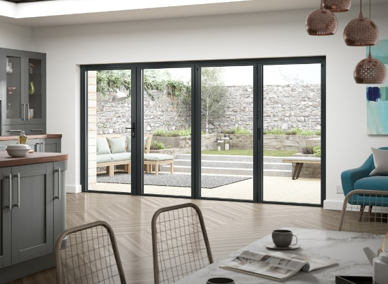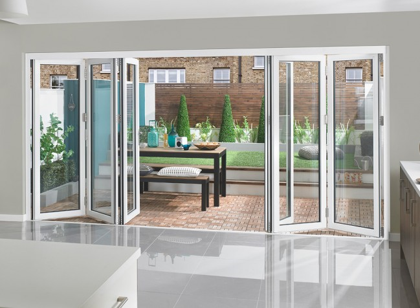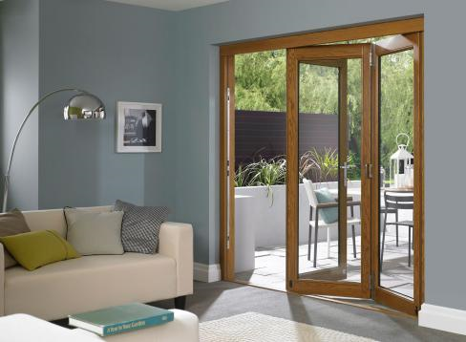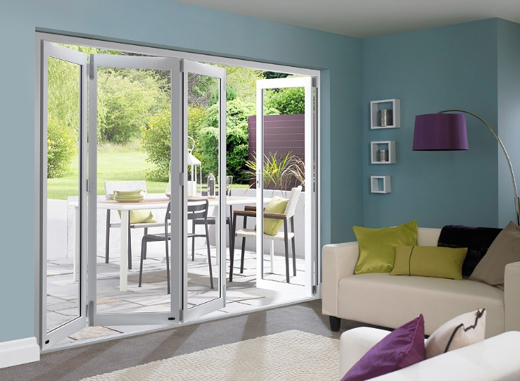Considerations when buying a kitchen bifold
When purchasing a bifold door for the kitchen, you should consider the following factors to help you decide which type of bifold you to buy:
Energy efficiency
Energy efficiency is important when choosing bifold doors. An energy-efficient door keeps your rooms cool in the summer and warm in the winter. This saves you money and keeps your kitchen properly insulated.
The best way to keep your room insulated is by choosing a bifold door system with a low U-value.
What is U-value?
The U-value measures how effectively a material insulates a room. This is obviously important as it will directly impact how much heat is lost from your home.
When checking the U-value of a certain material: the lower the U-value, the better the insulation of a material.
Bifold doors may have two U-values for each major component – the glass U-value and the frame U-value. Generally, the U-value of the glass is better than that of the frame due to glazing and thermal breaks. The two separate U-values are then combined to a single overall U-value.
When is the U-value the most important?
Large openings and extensions require particular attention to U-values. The larger the opening, the more important the U-value.
Both of these examples require particular U-value consideration because of the differences between window/door and brick wall U-values:
- The standard modern brick wall has a U-value of 0.8
- The regulations for bifold doors are 1.4 W/m2K. Vufold bifolds have U-values as low as 1.0 W/m2k (Vufold Ultra range).
Glass / glazing
The type of glazing on a set of kitchen bifolds will affect the U-value and therefore the thermal efficiency of the door. There are three types of glazing:
Read our full guide to the glazing options for bifold doors here.
Single vs double vs triple glazing
| Type of glazing |
Pros |
Cons |
|
Single
|
- The cheapest form of glazing
|
- Against building regulations for modern homes
- Has a high U-value of around 5.0 W/(m2K) meaning it is a poor insulator
|
|
Double
|
- Excellent thermal insulation
- Reduces the cost of heating bills
- Keeps you cool in the summer
|
- May not be allowed in listed properties
|
|
Triple
|
- The best thermally insulated glazing
- Will save the most money on heating bills
|
- The most expensive choice of glazing
|
Sightlines
Sightlines are the non-glass sections of bifold doors — where two panels of the bifold doors meet (also known as the door stiles). Aluminium ensures the thinnest sightlines, allowing you to get the most from a view. This is because aluminium is stronger and therefore can support more glass with less surrounding material.
How many door leafs should a bifold have for the best view?
Sightlines sit between each glass door leaf on a bifold door. The more doors leafs you have, the more sightlines. Because sightlines can impede the view, the general rule of thumb is: the fewer leafs, the better.
However, a balance needs to be considered. While larger doors can offer fewer sightlines, extremely large doors can be harder to operate.
Expert quote: “While large doors have their place, for me, the ideal door width is a metre.” - Rick Collins, Director, Vufold
Ventilation
Kitchen ventilation is important to ensure condensation is kept at a minimum. If your kitchen has poor ventilation, you may find condensation appearing on your bifold doors.
Fortunately, due to building regulations, it is unlikely that new kitchens will suffer from this problem.
However, if you do find condensation on your bifold, you will need to improve ventilation in your kitchen. This includes:
- Purchasing an extractor fan above the cooker
- Ensuring there is at least one window in your kitchen that you can open
- If the bifold door is the only ‘window’ in the room, ensuring that it has trickle vents (a small opening that allows a small amount of ventilation)
Security
Two of the most common bifold door locks are:
- Multipoint lock* — multiple locking mechanisms for added security
- Mortice lock – a single point locking system that is embedded into the door for a flush finish
Multipoint vs mortice locks
| Type of lock |
Pros |
Cons |
|
Multi-point
|
- More locking points make it harder to force a door
- Offers three times the level of security compared to single deadbolts or mortice locks
- Insurance companies favour multi-point locks due to their security.
- Vectis multipoint locks* are approved due to their high security specification.
|
- If you don’t know how to operate the locking system you may not lock the door properly — although this is unlikely
|
|
Mortice
|
- Can be keyed alike (multiple doors can use the same key)
- Can be upgraded to higher standard or security
|
- Single point of locking offers less security
- Multiple lever systems can be confusing
- 3-lever systems or less is unlikely to conform to BS3621 meaning it may not be ested against burglar techniques
|
*Vufold supplies door handles that fit a Vectis type multipoint locking system.
Find out more about bifold door security features here.







